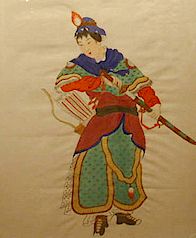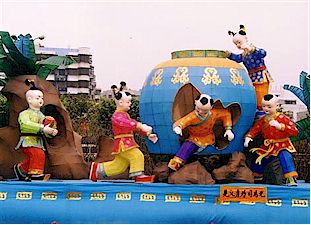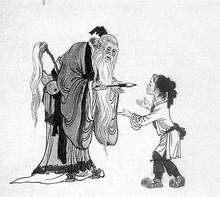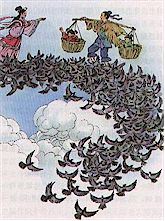On this page you will learn about the origins of the stories, how the characters in the stories are perceived by Chinese people and obtain links to other Website resources. I'm also indicating approximate age groups of Chinese students when they learn about these stories. However, all the stories can be taught at different levels to K-12 students around the world in order to learn about Chinese culture.
You can jump back to the stories by clicking on the images of story names.
Here's a story index:
1. How the Pheonix Became
the Queen of Birds - Animal Myth (K-3)
2. Hua Mu Lan, the Woman Warrior - Myth and Legend (K-9)
3. Mogao and Crescent Moon - Myth and Love Story (6-9)
4. Si Ma Guang Breaks the Tank - Famous People's Childhood
Story (K-3)
5. Cao Chong Weighs an Elephant - Famous People's Childhood
Story (K-3)
6. The Peacock Princess - Ethnic Group Legend and Love Story
(K-6)
7. Ma Liang and his Magical Brush - Folk Myth (K-9)
8. Niu Lang and Zhi Nu - Folk Story and Love Story (6-9)
 Phoenix,
as long with Dragons, is Chinese people's favorite magical creature. It can
symbolize many things: eternal life, self-sacrifice, reincarnation, feminine
power, bride, women (versus Dragon being symbolic of men and masculine power),
etc. Some people in China say that the idea for the phoenix (a made up bird)
came from the peacock. But others say it was the turkey that inspired the
invention of the queen of birds. In the old days in China, people thought
turkeys were brave and that their feathers brought good luck and protection.
So, they decorated their clothes with turkey feathers and eventually invented
a magical bird that looked like a turkey to express their hopes for a good
life.
Phoenix,
as long with Dragons, is Chinese people's favorite magical creature. It can
symbolize many things: eternal life, self-sacrifice, reincarnation, feminine
power, bride, women (versus Dragon being symbolic of men and masculine power),
etc. Some people in China say that the idea for the phoenix (a made up bird)
came from the peacock. But others say it was the turkey that inspired the
invention of the queen of birds. In the old days in China, people thought
turkeys were brave and that their feathers brought good luck and protection.
So, they decorated their clothes with turkey feathers and eventually invented
a magical bird that looked like a turkey to express their hopes for a good
life.
Scholars say that dragons, on the other hand, are probably based on either large snakes or crocodiles, only the imagined creature came out much longer. Some dragons are, according to myth, the length of a football field.
The story of bai niao chao feng is most commonly recorded in Chinese traditional music, embroidery and porcelain.

 Hua
Mu Lan is no doubt the most famous Chinese woman warrior. There are many myths
about her. One of them says Mulan used to be a goddess in the heavenly court.
Because she made a mistake, she was given the punishment of living and fighting
in the earthly world to redeem her sin. Since she was actually a goddess,
according to the legend, she had extraordinary skills and made an outstanding
general.
Hua
Mu Lan is no doubt the most famous Chinese woman warrior. There are many myths
about her. One of them says Mulan used to be a goddess in the heavenly court.
Because she made a mistake, she was given the punishment of living and fighting
in the earthly world to redeem her sin. Since she was actually a goddess,
according to the legend, she had extraordinary skills and made an outstanding
general.
Mulan's story was written down in a long ancient poem called Mulan Ci. Nowadays, Chinese students study this poem when they are in grade six or seven and they have to recite the whole piece by the end of the school year. The image on the right is an oil painting of Mulan on a piece of silk. (Image courtesy of the Dwight Eisenhower Presidential Library and Museum, Abilene, Kansas) If you are interested, click here for a production still of a TV series called Hua Mu Lan produced in 1999 in China. Click on the BACK button to return to this page.
 The
Mogao Cave and Crescent Moon Lake now sit side-by-side quietly in the Gobi
Desert of Gansu Province, close to where the Silk Road used to be. The Mogao
Cave, believed to be constructed from 366 AD, hosts 492 cells full of invaluable
Buddhist sculptures, murals and prayer scrolls. It was added to the UNESCO's
Cultural Heritage List in 1987. More information about Mogao Cave and Crescent
Moon Lake can be found in E-Travel Log #5.
You can also click
here for UNESCO World Heritage Website for more information about the
Mogao Cave. Click
on the BACK button to return to this page.
The
Mogao Cave and Crescent Moon Lake now sit side-by-side quietly in the Gobi
Desert of Gansu Province, close to where the Silk Road used to be. The Mogao
Cave, believed to be constructed from 366 AD, hosts 492 cells full of invaluable
Buddhist sculptures, murals and prayer scrolls. It was added to the UNESCO's
Cultural Heritage List in 1987. More information about Mogao Cave and Crescent
Moon Lake can be found in E-Travel Log #5.
You can also click
here for UNESCO World Heritage Website for more information about the
Mogao Cave. Click
on the BACK button to return to this page.

 Si
Ma Guang was a great philosopher, politician and calligraphy artist in Bei
Song Dynasty, around 1,000A.D.
Si
Ma Guang was a great philosopher, politician and calligraphy artist in Bei
Song Dynasty, around 1,000A.D.
Click
here for an image of Si Ma Guang's calligraphy work. Click
on the BACK button to return to this page.
The image on the right shows a piece of folk art depicting the famous story of how the child Si Ma Guang saved the day with his intelligence (Photo courtesy of Foshan Folk Art Institute, Guangdong, China).
 Do you think Cao
Chong was clever? Well, unfortunately, because he was so intelligent, his
older brother was very jealous and afraid that Cao Cao was going to make him
the heir. After Cao Cao passed away, the brother put Cao Chong into jail,
where he spent the rest of his unhappy life. In jail, Cao Chong wrote a famous
poem in which he implied the question to his brother, 'We were born from the
same root, why are you so anxious to hurt me?' It’s a line that many
Chinese parents still use today when brothers or sisters or cousins are not
behaving nicely to each other. They may be asked to recite the poem aloud
and then ponder the meaning of it before they make up. Click
here for the poem. Click on the BACK
button to return to this page.
Do you think Cao
Chong was clever? Well, unfortunately, because he was so intelligent, his
older brother was very jealous and afraid that Cao Cao was going to make him
the heir. After Cao Cao passed away, the brother put Cao Chong into jail,
where he spent the rest of his unhappy life. In jail, Cao Chong wrote a famous
poem in which he implied the question to his brother, 'We were born from the
same root, why are you so anxious to hurt me?' It’s a line that many
Chinese parents still use today when brothers or sisters or cousins are not
behaving nicely to each other. They may be asked to recite the poem aloud
and then ponder the meaning of it before they make up. Click
here for the poem. Click on the BACK
button to return to this page.
 The story of the Peacock Princess is like the story
of Swan Lake of the east. It's very popular among Chinese people and was made
into a movie decades ago. It was set in the beautiful Xishuangbanna rain forest
region of Southwest China - one of the few places in the world to be home
to wild blue, green and white peacocks. The story originated within the people
of Dai ethnic group who worshiped peacocks.
The story of the Peacock Princess is like the story
of Swan Lake of the east. It's very popular among Chinese people and was made
into a movie decades ago. It was set in the beautiful Xishuangbanna rain forest
region of Southwest China - one of the few places in the world to be home
to wild blue, green and white peacocks. The story originated within the people
of Dai ethnic group who worshiped peacocks.
Click here for an article and photos of one of the most famous Chinese dancers who created and performed the 'Peacock Princess' dance. Click here to go to E-Travel Log #8 for more information and Web site resources about the Xishuangbanna rain forest region. Click on the BACK button to return to this page.

 The
Story of Ma Liang and his magical brush is very popular among Chinese children
and is a typical example of traditional Chinese folk stories. China has a
long history of being a Feudalistic society where the rich owned the land
and stayed rich by passing their wealth to their children; and the poor stayed
poor no matter how hard they worked. Chinese folk stories typically depicted
the rich as greedy, mean and foolish, and the poor as diligent and intelligent.
In the stories, the poor could always outwit the rich and eventually bring
justice to their lives.
The
Story of Ma Liang and his magical brush is very popular among Chinese children
and is a typical example of traditional Chinese folk stories. China has a
long history of being a Feudalistic society where the rich owned the land
and stayed rich by passing their wealth to their children; and the poor stayed
poor no matter how hard they worked. Chinese folk stories typically depicted
the rich as greedy, mean and foolish, and the poor as diligent and intelligent.
In the stories, the poor could always outwit the rich and eventually bring
justice to their lives.
In this story, Ma Liang is generous, brave and kind. Even though he was just a child, he wasn't intimidated by adults with great powers; nor was he tempted by money. He could use his magical brush to get everything he wanted yet he only used it to help the poor. His story filled Chinese children of many generations with joy -- and dreams to have their own magical brush one day.
What would you do if you had a magical brush?
 The
story of Niu Lang and Zhi Nu is known to every house-hold in China. The story
has been recorded as far back as the Jin Dynasty (256-420 AD). The story was
also adapted to operas, TV series and even TV commercials.
The
story of Niu Lang and Zhi Nu is known to every house-hold in China. The story
has been recorded as far back as the Jin Dynasty (256-420 AD). The story was
also adapted to operas, TV series and even TV commercials.
Niu Lang literally means the man of ox, and Zhi Nu means the woman that embroiders, which explains why Niu Lang's best friend is a bull and that Zhi Nu embroiders at home when Niu Lang worked in the field.
Today the names of Niu Lang and Zhi Nu are nicknames for couples separated by distance. For instance, if a soldier is sent to patrol the border of China and his/her spouse stays at home, they would be called Niu Lang and Zhi Nu.
The reason Zhi Nu was able to live with
Niu Lang for several years before she was summoned back to the Heavenly Court is that, according to popular Chinese myths, one day in the Heavenly
Court is seven years on the earth. It didn't take long for the Emperess to
find out her granddaughter was missing, but long enough for Zhi Nu to build
a family on earth!
Court is that, according to popular Chinese myths, one day in the Heavenly
Court is seven years on the earth. It didn't take long for the Emperess to
find out her granddaughter was missing, but long enough for Zhi Nu to build
a family on earth!
In the story, Zhi Nu flew away on a cloud. Chinese legends always have it that godly creatures ride clouds when they fly.
Every year on July 7th of Chinese Lunar Calendar, grannies tell children that they wouldn't find many sparrows that day because they fly to form the bridge for Niu Lang and Zhi Nu. The image on the right shows how Niu Lang and Zhi Nu meet on the Sparrow Bridge (que qiao). (Image courtesy of China Radio International)
The Heavenly Court is a mythical place
in many Chinese legends where the gods live.
Note: This page contains
links linking to Web pages outside of OneWorld Classrooms' Web
Site. Although we review the Web Sites for appropriateness, OneWorld Classrooms is not responsbile for their content. |
Reading
Fun: Folk Stories |

